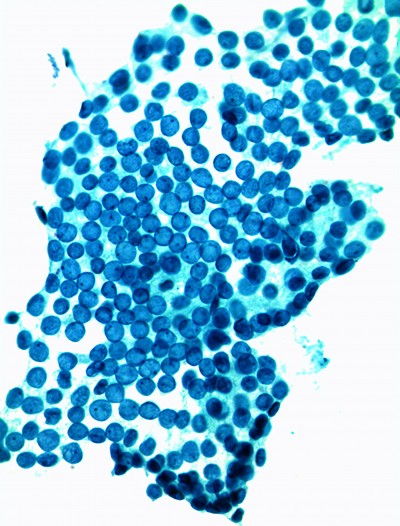News & Publications
Use of E-Cadherin & P120ctn IHC for Breast Carcinoma
August 31, 2011
By David C. Hoak, M.D.

Invasive ductal carcinoma: E-cadherin & p120ctn reveals red-brown staining of membrane
Invasive ductal carcinoma of the breast is the most common type of breast cancer. Approximately 55% of patients will develop this form of breast cancer. Invasive lobular carcinoma is less common with only about 10% of breast cancer patients diagnosed with this type of cancer. These two tumor subtypes are distinguished on the basis of their histology. Ductal tumors arise from the milk ducts and tend to form glandular structures, while lobular tumors arise from the breast lobules where breast milk is made during lactation. The cancer cells of invasive lobular carcinoma are less cohesive and tend to invade tissue as single cells. Lobular tumors are often slower growing than ductal tumors, more often estrogen and progesterone receptor positive and the tumor is more frequently larger in size than suspected clinically.
When pathologists examine a patient’s breast cancer under the microscope, it can sometimes be difficult to distinguish invasive ductal carcinoma from invasive lobular carcinoma. In other words, some ductal carcinoma can mimic lobular carcinoma and vice versa.
E-cadherin is useful in distinguishing between ductal and lobular cancer because it was recently discovered that lobular carcinomas have genetic mutations resulting in the loss of E-cadherin. E-cadherin is a molecule that projects from the membrane of epithelial cells to ensure that the cells “adhere” together, like “velcro”. E-cadherin is present in most epithelia and therefore is not specific for diagnostic use in metastatic carcinomas. Although treatment for stage-matched ductal versus lobular tumors is similar, some studies suggest that metastatic patterns differ between lobular and ductal tumors, and lobular tumors may be less responsive to neoadjuvant therapy.

Invasive lobular carcinoma: E-Cadherin negative (brown stain) & P120ctn positive (red stain)
In addition to the absence of immunodetectable E-cadherin in lobular carcinoma, there is diffuse localization of the molecule P120 catenin throughout the cytoplasm in lobular cancers. Catenins are proteins found in complexes with cadherin cell adhesion molecules of many animal cells.
In contrast, ductal carcinoma cells retain the membrane immunostaining pattern of P120 catenin, reflecting the normal construction of the E-cadherin complex.
E-cadherin and p120 catenin are markers used to distinguish between ductal carcinoma in-situ (DCIS) and lobular carcinoma in-situ (LCIS). Sometimes DCIS cells can extend into the breast lobules and mimic LCIS. In some patients, LCIS can extend into the major ducts and mimic DCIS. Ductal carcinoma in-situ will show positive membranous immunostaining for E-cadherin and p120-catenin. Lobular carcinoma in-situ will not express E-cadherin and p120 catenin will be located in the cytoplasm rather than on the membrane.
 Immunohistochemistry for E-cadherin is now widely used as an adjunct antibody for differentiating ductal from lobular pre-invasive and invasive lesions. This is particularly useful for lesions with indeterminate morphology and is important clinically because of the distinct management implications of ductal and lobular cancers.
Immunohistochemistry for E-cadherin is now widely used as an adjunct antibody for differentiating ductal from lobular pre-invasive and invasive lesions. This is particularly useful for lesions with indeterminate morphology and is important clinically because of the distinct management implications of ductal and lobular cancers.
Tubulolobular carcinoma is a less common type of mammary carcinoma that displays a mixture of invasive tubules and lobular cells. It is a rare subtype of breast carcinoma intermediate between ductal and lobular in
differentiation, representing less than 3% of all breast carcinomas. A criterion of 75% of the tumor showing a tubulolobular pattern has been determined.
| Tumor Subtype | E-cadherin | p120 catenin |
| ductal carcinoma | membrane staining brown | membrane staining red |
| lobular carcinoma | no membrane staining | cytoplasmic staining red |
| tubulobular carcinoma | + in tubular areas | + in lobular areas |
A tubulolobular tumor consists of a mixture of small tubules and cell cords. The tubules are round, lacking the angularity and apical snouts typical of tubular carcinoma. A minor component may be pure tubular or pure lobular (< 25%). Tubulolobular carcinoma of the breast is thus a distinct type of mammary carcinoma that displays both tubular and lobular patterns histologically but displays the membranous E cadherin/catenin complex characteristic of the ductal immunophenotype.
E-cadherin displays membranous staining in tubular and tubulolobular carcinomas, and is negative in lobular carcinomas. P120ctn displays membranous staining in tubulolobular and tubular carcinomas and cytoplasmic staining in lobular carcinomas.
In summary, the combined use of E-cadherin and p120ctn immunostaining on a single slide is very helpful in subclassifying certain breast carcinomas.
